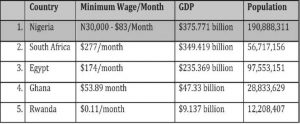[vc_row type=”vc_default” full_width=”stretch_row_content_no_spaces” css=”.vc_custom_1500547593342{padding-right: 100px !important;}” el_class=”noPaddinRow”][vc_column width=”1/6″ el_class=”noPaddingLeft” offset=”vc_hidden-md vc_hidden-sm vc_hidden-xs”][vc_raw_html]JTNDZGl2JTIwY2xhc3MlM0QlMjJtYWluLXN0cmlwJTIyJTNFJTBBJTNDZGl2JTIwY2xhc3MlM0QlMjJibHVlLXN0cmlwMCUyMiUzRSUzQyUyRmRpdiUzRSUwQSUzQ2RpdiUyMGNsYXNzJTNEJTIyYmx1ZS1zdHJpcDElMjIlM0UlM0MlMkZkaXYlM0UlMEElM0NkaXYlMjBjbGFzcyUzRCUyMmJsdWUtc3RyaXAyJTIyJTNFJTNDJTJGZGl2JTNFJTBBJTNDJTJGZGl2JTNF[/vc_raw_html][/vc_column][vc_column width=”5/6″ el_class=”justifyText” css=”.vc_custom_1530195741159{padding-right: 310px !important;}” offset=”vc_hidden-md vc_hidden-sm vc_hidden-xs”][vc_empty_space height=”50px”][vc_column_text]


[/vc_column_text][vc_empty_space height=”30px”][vc_row_inner el_id=”newsletters”][vc_column_inner width=”1/6″][/vc_column_inner][vc_column_inner width=”2/3″][vc_custom_heading text=”And Here Comes Nigeria’s New Minimum Wage?” font_container=”tag:h1|font_size:22|text_align:justify|color:%236699cc|line_height:1.8″ use_theme_fonts=”yes”][/vc_column_inner][vc_column_inner width=”1/6″][/vc_column_inner][/vc_row_inner][vc_empty_space height=”25px”][vc_column_text]
As a sequel to all the strikes, plots and counterplots between organized labour and the Federal government, the N30,000 minimum wage is now imminent. Following the approval of the President, and pending when the National Assembly does the needful, I intend to throw up a few discussion points arising in relation to this new minimum wage.
How do we compare with other African countries? I will use 5 random countries as benchmarks to underscore a few points:

It is clear from the above table that Nigeria is not on top of the chart in terms of a minimum wage despite being on top in GDP and population. Note that Nigeria’s population and the size of our work force should be a major factor in comparing minimum wages between countries. Do you realize that Nigeria’s population is almost the same as those of the other 4 countries put together?
In Nigeria, there have been several minimum wage increases: N3000 went up to N7500 in 1990, and N18, 000 in 2010 and now from N18, 000 to N30, 000 in 2018. Given the inflation statistics in Nigeria and the recent drastic devaluation of the naira there could be no better time for workers to ask for a wage increase: inflation has risen from an average of 9% between 2012 – 2015 to an average of 15% and predicted to be about 14% up to 2022. The Naira has lost over 50% of its value. However, whilst wage increases are salutary and expected from time to time, the currentsituation makes one wonder if both federal and state governments can afford this new wage.
Here are the true facts: Federal government revenue has been unsteady and sometimes on the decline in the last few years; government recurrent expenditure is not on the decline; and federal governments borrowing has risen drastically. It is also a known fact that several state governments, despite FGN bailouts, are still many months in arrears on salary payments and would therefore be burning their candles on both ends if they are saddled with paying the new wage and paying their salary arrears at the same time. When the National Assembly passes a new minimum wage bill, it will be interesting to see how this plays out in the months to come. Some of the issues to watch would be: How does government increase the pie to accommodate the wage increase? Would government resort to a reduction in the work force to accommodate this new wage bill? Would government seek to reduce inflation as a method of increasing the disposable income of workers? Do we have another crisis of failure in the waiting because the government is making a commitment it clearly knows it cannot implement?
[/vc_column_text][/vc_column][/vc_row][vc_row type=”vc_default” full_width=”stretch_row_content_no_spaces” css=”.vc_custom_1500547593342{padding-right: 100px !important;}” el_class=”noPaddinRow”][vc_column el_class=”noPaddingLeft” offset=”vc_hidden-lg vc_hidden-xs”][vc_raw_html]JTNDZGl2JTIwY2xhc3MlM0QlMjJ0YWItbWFpbi1zdHJpcCUyMiUzRSUwQSUzQ2RpdiUyMGNsYXNzJTNEJTIydGFiLWJsdWUtc3RyaXAwJTIyJTNFJTNDJTJGZGl2JTNFJTBBJTNDZGl2JTIwY2xhc3MlM0QlMjJ0YWItYmx1ZS1zdHJpcDElMjIlM0UlM0MlMkZkaXYlM0UlMEElM0NkaXYlMjBjbGFzcyUzRCUyMnRhYi1ibHVlLXN0cmlwMiUyMiUzRSUzQyUyRmRpdiUzRSUwQSUzQyUyRmRpdiUzRQ==[/vc_raw_html][vc_empty_space height=”25px”][vc_row_inner][vc_column_inner width=”1/6″][/vc_column_inner][vc_column_inner width=”2/3″][vc_column_text]


[/vc_column_text][vc_custom_heading text=”And Here Comes Nigeria’s New Minimum Wage?” font_container=”tag:h1|font_size:22|text_align:justify|color:%236699cc|line_height:1.8″ use_theme_fonts=”yes”][vc_column_text]
As a sequel to all the strikes, plots and counterplots between organized labour and the Federal government, the N30,000 minimum wage is now imminent. Following the approval of the President, and pending when the National Assembly does the needful, I intend to throw up a few discussion points arising in relation to this new minimum wage.
How do we compare with other African countries? I will use 5 random countries as benchmarks to underscore a few points:

It is clear from the above table that Nigeria is not on top of the chart in terms of a minimum wage despite being on top in GDP and population. Note that Nigeria’s population and the size of our work force should be a major factor in comparing minimum wages between countries. Do you realize that Nigeria’s population is almost the same as those of the other 4 countries put together?
In Nigeria, there have been several minimum wage increases: N3000 went up to N7500 in 1990, and N18, 000 in 2010 and now from N18, 000 to N30, 000 in 2018. Given the inflation statistics in Nigeria and the recent drastic devaluation of the naira there could be no better time for workers to ask for a wage increase: inflation has risen from an average of 9% between 2012 – 2015 to an average of 15% and predicted to be about 14% up to 2022. The Naira has lost over 50% of its value. However, whilst wage increases are salutary and expected from time to time, the currentsituation makes one wonder if both federal and state governments can afford this new wage.
Here are the true facts: Federal government revenue has been unsteady and sometimes on the decline in the last few years; government recurrent expenditure is not on the decline; and federal governments borrowing has risen drastically. It is also a known fact that several state governments, despite FGN bailouts, are still many months in arrears on salary payments and would therefore be burning their candles on both ends if they are saddled with paying the new wage and paying their salary arrears at the same time. When the National Assembly passes a new minimum wage bill, it will be interesting to see how this plays out in the months to come. Some of the issues to watch would be: How does government increase the pie to accommodate the wage increase? Would government resort to a reduction in the work force to accommodate this new wage bill? Would government seek to reduce inflation as a method of increasing the disposable income of workers? Do we have another crisis of failure in the waiting because the government is making a commitment it clearly knows it cannot implement?
[/vc_column_text][/vc_column_inner][vc_column_inner width=”1/6″][/vc_column_inner][/vc_row_inner][/vc_column][/vc_row][vc_row type=”vc_default” full_width=”stretch_row_content_no_spaces” css=”.vc_custom_1500547593342{padding-right: 100px !important;}” el_class=”noPaddinRow”][vc_column el_class=”noPaddingLeft” offset=”vc_hidden-lg vc_hidden-md vc_hidden-sm” css=”.vc_custom_1533215258743{padding-right: 75px !important;padding-left: 60px !important;}”][vc_raw_html]JTNDZGl2JTIwY2xhc3MlM0QlMjJtb2ItbWFpbi1zdHJpcCUyMiUzRSUwQSUzQ2RpdiUyMGNsYXNzJTNEJTIybW9iLWJsdWUtc3RyaXAwJTIyJTNFJTNDJTJGZGl2JTNFJTBBJTNDZGl2JTIwY2xhc3MlM0QlMjJtb2ItYmx1ZS1zdHJpcDElMjIlM0UlM0MlMkZkaXYlM0UlMEElM0NkaXYlMjBjbGFzcyUzRCUyMm1vYi1ibHVlLXN0cmlwMiUyMiUzRSUzQyUyRmRpdiUzRSUwQSUzQyUyRmRpdiUzRQ==[/vc_raw_html][vc_empty_space height=”25px”][vc_row_inner][vc_column_inner width=”1/6″][/vc_column_inner][vc_column_inner width=”2/3″][vc_column_text]


[/vc_column_text][vc_custom_heading text=”And Here Comes Nigeria’s New Minimum Wage?” font_container=”tag:h1|font_size:22|text_align:justify|color:%236699cc|line_height:1.8″ use_theme_fonts=”yes”][vc_column_text]
As a sequel to all the strikes, plots and counterplots between organized labour and the Federal government, the N30,000 minimum wage is now imminent. Following the approval of the President, and pending when the National Assembly does the needful, I intend to throw up a few discussion points arising in relation to this new minimum wage.
How do we compare with other African countries? I will use 5 random countries as benchmarks to underscore a few points:

It is clear from the above table that Nigeria is not on top of the chart in terms of a minimum wage despite being on top in GDP and population. Note that Nigeria’s population and the size of our work force should be a major factor in comparing minimum wages between countries. Do you realize that Nigeria’s population is almost the same as those of the other 4 countries put together?
In Nigeria, there have been several minimum wage increases: N3000 went up to N7500 in 1990, and N18, 000 in 2010 and now from N18, 000 to N30, 000 in 2018. Given the inflation statistics in Nigeria and the recent drastic devaluation of the naira there could be no better time for workers to ask for a wage increase: inflation has risen from an average of 9% between 2012 – 2015 to an average of 15% and predicted to be about 14% up to 2022. The Naira has lost over 50% of its value. However, whilst wage increases are salutary and expected from time to time, the currentsituation makes one wonder if both federal and state governments can afford this new wage.
Here are the true facts: Federal government revenue has been unsteady and sometimes on the decline in the last few years; government recurrent expenditure is not on the decline; and federal governments borrowing has risen drastically. It is also a known fact that several state governments, despite FGN bailouts, are still many months in arrears on salary payments and would therefore be burning their candles on both ends if they are saddled with paying the new wage and paying their salary arrears at the same time. When the National Assembly passes a new minimum wage bill, it will be interesting to see how this plays out in the months to come. Some of the issues to watch would be: How does government increase the pie to accommodate the wage increase? Would government resort to a reduction in the work force to accommodate this new wage bill? Would government seek to reduce inflation as a method of increasing the disposable income of workers? Do we have another crisis of failure in the waiting because the government is making a commitment it clearly knows it cannot implement?
[/vc_column_text][/vc_column_inner][vc_column_inner width=”1/6″][/vc_column_inner][/vc_row_inner][/vc_column][/vc_row]
